Blog
A 1-2 Punch: How Alarm Surveillance to Increases Safety, Decreases Noise
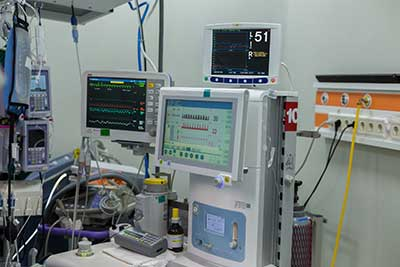 An often-cited study at Johns Hopkins Hospital found that there is a daily average of 350 alarms per bed in hospital critical care units. That means that all day (and night) long, critical care nurses are fielding hundreds of audible alarms from infusion pumps, cardiac monitors, ventilators, and other bedside machines.
An often-cited study at Johns Hopkins Hospital found that there is a daily average of 350 alarms per bed in hospital critical care units. That means that all day (and night) long, critical care nurses are fielding hundreds of audible alarms from infusion pumps, cardiac monitors, ventilators, and other bedside machines.
These nearly constant alarms compete for a nurse’s attention and are not prioritized by criticality. Worst of all, the majority of the messages aren’t relevant or actionable. All the noise can lead to deadly consequences should a caregiver become desensitized and assume an alarm is false or misdirected.
Study: Nuisance Alarms on the Rise
It’s no secret to nurses (or hospital administrators) that alarm fatigue is a persistent problem. A 2018 article in the American Journal of Critical Care (AJCC) reported the findings of a clinical alarms survey (conducted at five-year intervals since 2006) to see how the challenge of alarm fatigue is trending.
The most recent survey results from over 1,200 clinicians (mostly nurses) are not encouraging, including responses to a key question about so-called “nuisance alarms.” More respondents than ever report that nuisance alarms occur frequently, disrupt patient care, and reduce trust in alarms.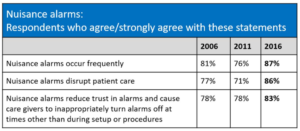
Alarm Management Also Increasing, Fueled by National Patient Safety Goals
On the positive side, in comparison to 2011, the 2016 survey results show a higher proportion of respondents whose organizations have instituted clinical alarm initiatives or alarm management technologies. (These questions weren’t asked in 2006.)
A powerful push for that increase was a 2014 National Patient Safety Goal from the Joint Commission. The first phase of the NPSG gave hospital leaders a year to collect input on alarm signal management from frontline staff and compile best practices. The second phase required hospitals to establish specific policies for alarm safety and complete staff education on them by Jan. 1, 2016.
Progress is being made, but there’s clearly still much work to do, and it’s alarm surveillance and management technology that clinicians on the frontlines are seeking: Nearly two-thirds (65 percent) of clinicians (over half registered nurses) who responded to a survey by the Healthcare Technology Foundation agreed with the statement “Smart alarms would be effective for reducing false alarms,” and 69 percent agreed that smart alarms could also improve clinical response to important patient alarms.
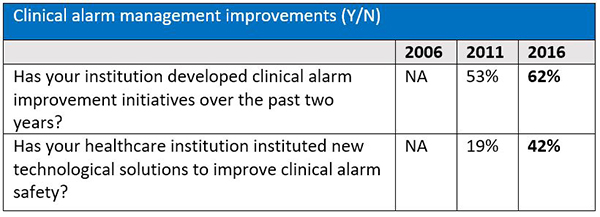
Two Ways to Increase Safety and Calm Noisy Environments
Many hospitals are still not efficiently using alarm management, as reported by the AJCC article above. Spok Alarm Surveillance powered by Bernoulli combines advanced filtering, routing and escalation capabilities to support better clinical decision-making, speed response times, reduce alarm fatigue, and improve patient satisfaction. Here are two examples of typical workflows improved with alarm surveillance technology:
1. Filter out non-actionable alarms
A great way to increase safety and minimize noise is to use alarm filtering technology. False positives from loose leads, redundant alerts from poorly set thresholds, and notifications for patients under someone else’s care all contribute to a noisy environment as well as distract caregivers. Not only are alerts often difficult to decipher or prioritize, they can also be dangerous if excessive alarms lead care teams to become desensitized.
Through integration with a variety of patient care devices and clinical systems such as ventilators, pulse oximeters, and patient monitors, alarm surveillance technology captures live streaming patient data to create unique smart alarms by taking into consideration various measurements. These smart alarms include:
- Combination alarms – When two or more independent patient measurements violate specific limit thresholds simultaneously.
- Consecutive alarms – When a patient measurement goes in and out of a limit threshold a given number of times over a specified amount of time.
- Sustained alarms – When a patient measurement violates a specific threshold for a specified minimum period of time.
The result is delivery of more relevant, actionable alarms to the right caregiver, as well as a dramatic reduction in the number of alarms. Moreover, this technology also provides escalation for unacknowledged alerts and allows hospitals to maintain a full audit trail of every notification—when it was received, viewed, and responded to. Here’s an example of a workflow where alarm filtering leads to actionable alerts and fewer interruptions to the care team.
Filter alarms to send actionable alerts
1. A patient’s monitor registers a drop in his blood oxygen saturation levels for several seconds before it returns to normal.
2. A patient in another room coughs, trigging a peak airway pressure alarm from her ventilator, but the device continues to operate normally, and the patient requires no clinical intervention.
3. Based on the hospital’s defined prioritizations, Spok Alarm Surveillance powered by Bernoulli filters out these non‐actionable alarms and does not pass them through to interrupt the nurse.
4. A third patient’s monitor measures decreased heartbeat and respiration rates – each change not enough to activate the monitor’s individual alarms, but together clinically significant – triggering a combination smart alarm.
5. Spok routes the alert to the mobile device for that patient’s nurse. The nurse makes an informed decision to visit that patient for appropriate follow‐up.
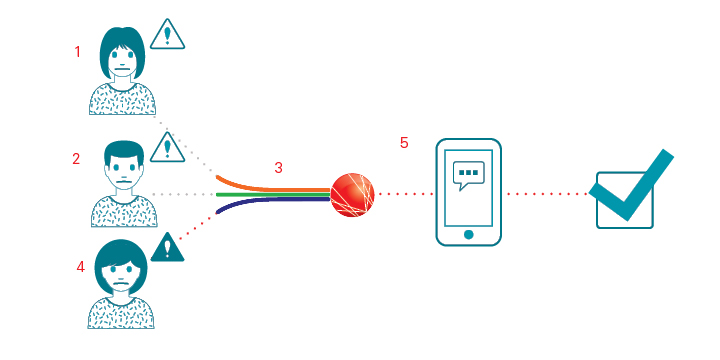
 2. Add clinical context
2. Add clinical context
Alarm surveillance technology can also capture live streaming data to create unique smart alarms by taking into consideration various measurements. Unlike traditional alarm management systems that are dependent on alarms triggered by the patient care device, Spok Alarm Surveillance includes integration of comprehensive, continuous patient data to enable advanced smart alarms and a more holistic view of the patient status.
Once the alarms are filtered, as illustrated in the previous workflow, Spok can then send the actionable alarms with clinical context to care team members on their mobile devices. This includes patient identification data, real-time patient data like current vital signs, and live-streaming waveforms.
Spok Alarm Surveillance, a FDA 510(k)‐cleared solution, accomplishes this by capturing and correlating real‐time patient data from the various patient care devices, including live-streaming waveforms, pulse rate, blood pressure, temperature, and oxygen saturation. Upon receiving a smart alarm notification from Spok, care teams can remotely view this critical data using their smartphones. These advanced remote monitoring capabilities provide caregivers with the additional clinical context needed for fast decision making around important clinical events, thus helping to improve care collaboration, staff efficiency, and patient outcomes.
Alarm Surveillance Makes a Big Difference for Patients and Staff
With an alarm surveillance solution, you’re effectively delivering a one-two punch to increase patient safety (and as a result, help improve patient outcomes) and help reduce alarm fatigue for staff. Intelligent alarm filtering and sending alerts to caregivers’ mobile devices with clinical context supports better, more informed clinical decision-making, and faster response times that make a difference in patient care.




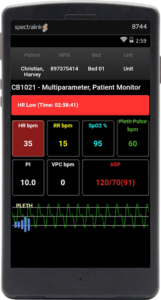 2. Add clinical context
2. Add clinical context
